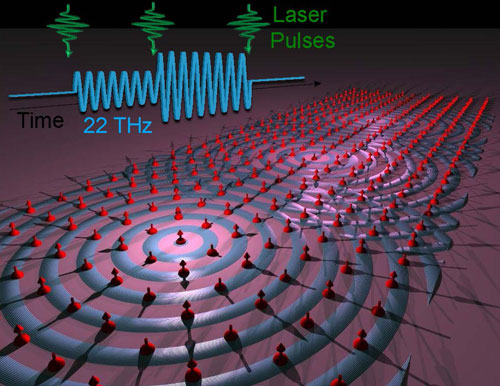Understanding Magnonics: Bridging the Gap in Next-Generation Computing
Definition: Magnonics is an emerging field of nanotechnology focused on the study and manipulation of magnons – quasiparticles associated with the collective spin waves in magnetic materials. This domain leverages the properties of magnons to transmit and process information, promising energy-efficient and high-speed data processing technologies beyond conventional electronics.

Principles of Magnonics
At the core of magnonics lies the concept of spin waves – oscillations in the orientation of spins in a magnetic material. These waves carry energy and information without the actual movement of matter, relying on the quantum mechanical property of spin. Magnons, the quantized units of these waves, behave similarly to particles and can be manipulated to propagate through magnetic materials, making them ideal for information transfer and processing.
How Does Magnonics Work?
In magnonics, information is encoded in the amplitude, phase, or other properties of spin waves. External magnetic fields, microwave antennas, or electrical currents can generate and control these waves within magnetic materials. By designing specific patterns of magnetic nanostructures, researchers can create pathways and circuits for magnons, analogous to electronic circuits but potentially at much higher speeds and lower energy costs.
Key Features of Magnonics
Magnonics is characterized by several distinct advantages:
- Low Energy Consumption: Unlike electrons in traditional electronics, magnons do not involve charge movement, which significantly reduces energy loss due to resistance and heating.
- High Processing Speed: Magnon-based devices can potentially operate at terahertz frequencies, far exceeding the speed of conventional semiconductor-based electronics.
- Compatibility with Spintronics: Magnonics complements spintronics, another field that exploits the spin of electrons rather than their charge, offering pathways to integrate memory and processing capabilities in novel computing architectures.
- Scalability: The ability to fabricate complex magnonic circuits on the nanoscale allows for high-density integration, critical for the development of future computing technologies.
Challenges and Opportunities in Magnonics
Despite its potential, magnonics faces technical challenges, including the efficient generation and detection of spin waves, controlling magnon scattering, and interfacing magnonic devices with existing electronic systems. Overcoming these obstacles requires advances in materials science, nanofabrication, and theoretical modeling.
Applications and Future Directions
Magnonics holds promise for a wide range of applications, from next-generation high-speed, low-power computing and data storage devices to sensors and quantum computing components. Ongoing research is exploring the use of novel magnetic materials, nanostructuring techniques, and hybrid systems that combine magnonics with electronics and photonics, aiming to unlock the full potential of this technology.
Further Reading
Nature Reviews Materials, Advances in coherent magnonics
Journal of Physics: Condensed Matter, The 2021 Magnonics Roadmap
